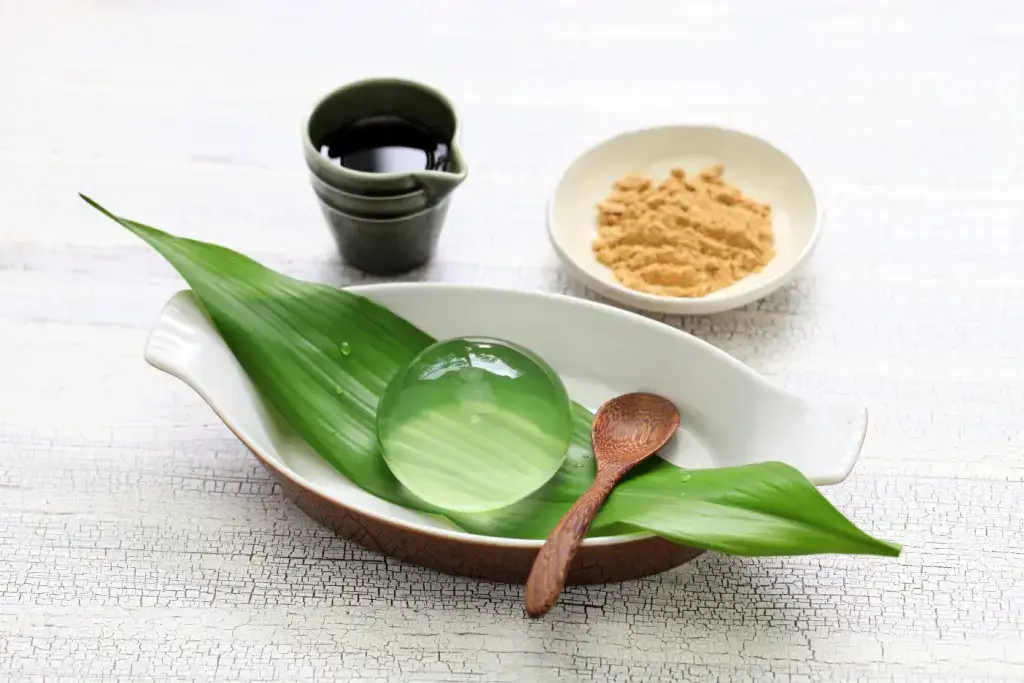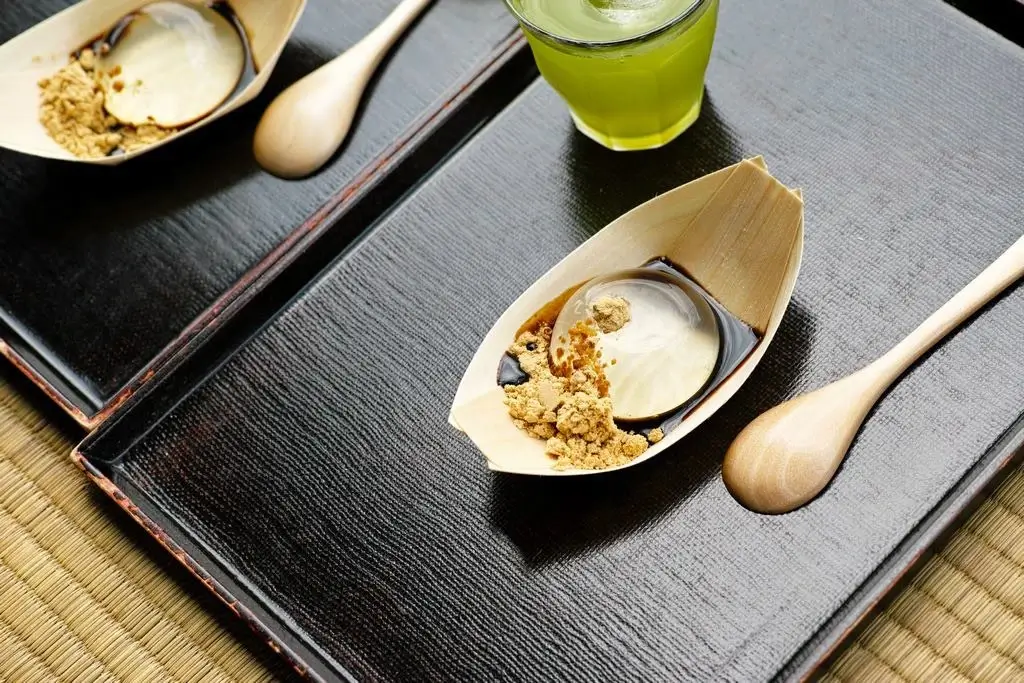Raindrop cake is a stunning culinary art that has captivated food enthusiasts worldwide. This unique Japanese delicacy is known for its crystal-clear appearance and subtle flavor. It’s a must-try for those seeking to experience Japan’s refined culinary traditions. Let’s explore the enchanting world of raindrop cake, uncovering its origins and popularity. We’ll discover where to find it in Japan and why it has become such a beloved delicacy.
Table of Contents
ToggleWhat is a “raindrop cake”?
Raindrop cake, or mizu shingen mochi, is a transparent jelly cake made with a special ingredient called agar powder instead of gelatin. This helps keep the flavor simple and clean. Additionally, the name “mizu shingen mochi” comes from Mount Shingen in Japan, known for its clean water. The cake looks like a clear raindrop, so it got its nickname!

Generally, this dessert comes with two toppings: kinako, a powder made from roasted soybeans, and kuromitsu, a yummy brown sugar syrup. These toppings make the dessert even more special because they add different textures and flavors. Biting into the smooth jelly cake and tasting the crunchy kinako and sweet syrup exemplify how Japanese cuisine values good taste and beautiful presentation.
Where did it come from?
The raindrop cake, also called mizu shingen mochi, first appeared in Japan, specifically in Nagano Prefecture. This new dessert reflects Japan’s love for simple and natural beauty in cooking. Its creation in Nagano connects it to the region’s culture and nature.

More specifically, Nagano is famous for its beautiful landscapes, and Mount Shingen is famous for its pure water. This link also explains why the cake resembles a clear raindrop shimmering in the sunlight. Overall, the raindrop cake tastes good and honors Japan’s respect for nature and innovative cooking based on local traditions. Its creation has also symbolized how Japanese cuisine blends old traditions with new ideas to create something unique.
Where can I enjoy raindrop cake in Japan?
If you are excited to try the raindrop cake, Japan has many shops famous for making this particular dessert. In other words, these places are experts at creating it, offering a chance to taste its delicate flavors and see its beautiful look up close. So, let’s explore some of the most famous places in Japan to try it!
Are you looking for fantastic wagashi? Check out Sakuraco! Sakuraco delivers traditional Japanese snacks, teas, and sweets from local Japanese makers directly to your door so you can enjoy the latest treats directly from Japan!
Kinseiken Wagashi (Yamanashi Prefecture)
Kinseiken Wagashi, nestled in the serene landscapes of Yamanashi Prefecture, stands out for its dedication to preserving and innovating traditional Japanese sweets. As a result, its inviting atmosphere welcomes visitors into a world of culinary craftsmanship.

This esteemed shop is renowned for its meticulous approach to creating mizu shingen mochi. It aims to evoke the pristine essence of Mount Shingen’s waters in every delicate raindrop cake it serves. Each visit to Kinseiken Wagashi undoubtedly offers a taste of its exquisite desserts. They always provide an opportunity to experience the cultural richness and artistry that define Japanese wagashi traditions.
Marumochiya (Kyoto Prefecture)

Located in historic Kyoto, Marumochiya offers a refined raindrop cake that aligns with the city’s cultural heritage. Visitors can generally savor this dessert amidst traditional Japanese decor, where the delicate flavors of agar and water are elevated to an art form. Marumochiya’s commitment to quality also ensures that each bite of their mizu shingen mochi exemplifies Kyoto’s culinary finesse and aesthetic refinement.
Mikan Club (Shibuya, Tokyo)
Embracing Tokyo’s vibrant culinary scene, Mikan Club infuses modern flair into its rendition of raindrop cake. Situated in the bustling Shibuya district, this establishment presents a contemporary interpretation of mizu shingen mochi that reflects Tokyo’s dynamic spirit. Moreover, the dessert is crafted with precision and creativity, offering a delightful contrast of textures and flavors that cater to traditionalists and adventurous food enthusiasts alike.

Why should I try raindrop cake?
You should try raindrop cake because it captivates not only with its beautiful appearance but also with a sensory experience that celebrates Japan’s culinary skills and cultural heritage. Like a cool summer rain, its jelly-like texture melts gently on the tongue, offering a delightful and unique sensation. Beyond being a dessert, raindrop cake is a cultural journey connecting you to Japan’s rich heritage and careful craftsmanship in wagashi. It also pays tribute to Mount Shingen’s pure waters and showcases Japan’s admiration for natural beauty.
Whether exploring serene Yamanashi, historic Kyoto, or busy Tokyo, trying this exquisite wagashi offers pure joy and cultural immersion. Experience the magic of raindrop cake and discover why it enchants food lovers worldwide. Have you ever tried these delicious raindrop cakes, or does this tempting dessert intrigue you? Share your thoughts and experiences with us in the comments below—we would love to hear from you!











